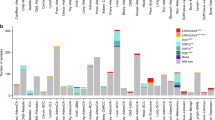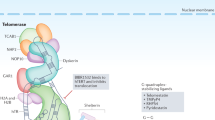Abstract
Telomeres are specialized nucleoprotein complexes that serve as protective caps of linear eukaryotic chromosomes. Loss of telomere function is associated with rampant genetic instability and loss of cellular viability and renewal potential. The telomere also participates in processes of chromosomal repair, as evidenced by the ‘capture’ or de novo synthesis of telomere repeats at double-stranded breaks1,2,3,4 and by the capacity of yeast telomeres to serve as repositories of essential components of the DNA repair machinery, particularly those involved in non-homologous end-joining5,6,7 (NHEJ). Here we used the telomerase-deficient mouse, null for the essential telomerase RNA gene (Terc), to assess the role of telomerase and telomere function on the cellular and organismal response to ionizing radiation. Although the loss of telomerase activity per se had no discernable impact on the response to ionizing radiation, the emergence of telomere dysfunction in late-generation Terc−/− mice imparted a radiosensitivity syndrome associated with accelerated mortality. On the cellular level, the gastrointestinal crypt stem cells and primary thymocytes showed increased rates of apoptosis, and mouse embryonic fibroblasts (MEFs) showed diminished dose-dependent clonogenic survival. The radiosensitivity of telomere dysfunctional cells correlated with delayed DNA break repair kinetics, persistent chromosomal breaks and cytogenetic profiles characterized by complex chromosomal aberrations and massive fragmentation. Our findings establish a intimate relationship between functionally intact telomeres and the genomic, cellular and organismal response to ionizing radiation.
This is a preview of subscription content, access via your institution
Access options
Subscribe to this journal
Receive 12 print issues and online access
$209.00 per year
only $17.42 per issue
Buy this article
- Purchase on Springer Link
- Instant access to full article PDF
Prices may be subject to local taxes which are calculated during checkout




Similar content being viewed by others
References
Sprung, C.N., Reynolds, G.E., Jasin, M. & Murnane, J.P. Chromosome healing in mouse embryonic stem cells. Proc. Natl Acad. Sci. USA 96, 6781–6786 ( 1999).
Slijepcevic, P., Natarajan, A.T. & Bryant, P.E. Telomeres and radiation-induced chromosome breakage . Mutagenesis 13, 45–49 (1998).
Meltzer, P.S., Guan, X.Y. & Trent, J.M. Telomere capture stabilizes chromosome breakage. Nature Genet. 4, 252–255 (1993).
Murnane, J.P. & Yu, L.C. Acquisition of telomere repeat sequences by transfected DNA integrated at the site of a chromosome break. Mol. Cell. Biol. 13, 977–983 (1993).
Haber, J.E. Sir-Ku-itous routes to make ends meet. Cell 97, 829–832 (1999).
Mills, K.D., Sinclair, D.A. & Guarente, L. MEC1-dependent redistribution of the Sir3 silencing protein from telomeres to DNA double-strand breaks. Cell 97, 609–620 (1999).
Martin, S.G., Laroche, T., Suka, N., Grunstein, M. & Gasser, S.M. Relocalization of telomeric Ku and SIR proteins in response to DNA strand breaks in yeast. Cell 97, 621–633 (1999).
Blasco, M.A. et al. Telomere shortening and tumor formation by mouse cells lacking telomerase RNA. Cell 91, 25– 34 (1997).
Lee, H.W. et al. Essential role of mouse telomerase in highly proliferative organs . Nature 392, 569–574 (1998).
Rudolph, K.L. et al. Longevity, stress response, and cancer in aging telomerase-deficient mice. Cell 96, 701–712 (1999).
Hall, E.J. Radiobiology for the Radiologist (J.B. Lippincott, Philadelphia, 1988).
Chin, L. et al. p53 deficiency rescues the adverse effects of telomere loss and cooperates with telomere dysfunction to accelerate carcinogenesis. Cell 97, 527–538 ( 1999).
Potten, C.S. & Loeffler, M. Stem cells: attributes, cycles, spirals, pitfalls and uncertainties. Lessons for and from the crypt. Development 110, 1001–1020 (1990).
Scully, R. et al. Genetic analysis of BRCA1 function in a defined tumor cell line. Mol. Cell 4, 1093– 1109 (1999).
Gao, Y. et al. A critical role for DNA end-joining proteins in both lymphogenesis and neurogenesis. Cell 95, 891– 902 (1998).
Weaver, D.T. Regulation and repair of double-strand DNA breaks. Crit. Rev. Eukaryot. Gene Expr. 6, 345–375 ( 1996).
Jeggo, P.A. Identification of genes involved in repair of DNA double-strand breaks in mammalian cells. Radiat. Res. 150, S80– 91 (1998).
Liang, F., Han, M., Romanienko, P.J. & Jasin, M. Homology-directed repair is a major double-strand break repair pathway in mammalian cells. Proc. Natl Acad. Sci. USA 95, 5172–5177 (1998).
Hesse, J.E., Lieber, M.R., Gellert, M. & Mizuuchi, K. Extrachromosomal DNA substrates in pre-B cells undergo inversion or deletion at immunoglobulin V-(D)-J joining signals. Cell 49, 775–783 (1987).
Taccioli, G.E. et al. Impairment of V(D)J recombination in double-strand break repair mutants. Science 260, 207– 210 (1993).
Frank, K.M. et al. Late embryonic lethality and impaired V(D)J recombination in mice lacking DNA ligase IV. Nature 396, 173–177 (1998).
Gao, Y. et al. A targeted DNA-PKcs-null mutation reveals DNA-PK-independent functions for KU in V(D)J recombination. Immunity 9, 367–376 (1998).
Grawunder, U., Zimmer, D., Fugmann, S., Schwarz, K. & Lieber, M.R. DNA ligase IV is essential for V(D)J recombination and DNA double-strand break repair in human precursor lymphocytes. Mol. Cell 2, 477–484 ( 1998).
Gu, Y. et al. Growth retardation and leaky SCID phenotype of Ku70-deficient mice . Immunity 7, 653–665 (1997).
Li, Z. et al. The XRCC4 gene encodes a novel protein involved in DNA double-strand break repair and V(D)J recombination. Cell 83, 1079–1089 (1995).
Riballo, E. et al. Identification of a defect in DNA ligase IV in a radiosensitive leukaemia patient. Curr. Biol. 9, 699– 702 (1999).
Sturzbecher, H.W., Donzelmann, B., Henning, W., Knippschild, U. & Buchhop, S. p53 is linked directly to homologous recombination processes via RAD51/RecA protein interaction. EMBO J. 15, 1992–2002 ( 1996).
Garabedian, E.M., Roberts, L.J., McNevin, M.S. & Gordon, J.I. Examining the role of Paneth cells in the small intestine by lineage ablation in transgenic mice. J. Biol. Chem. 272, 23729–23740 (1997).
Savage, J.R.K. Classification and relationships of induced chromosomal structural changes . J. Med. Genet. 12, 103– 122 (1975).
Kiltie, A.E. & Ryan, A.J. SYBR Green I staining of pulsed field agarose gels is a sensitive and inexpensive way of quantitating DNA double-strand breaks in mammalian cells. Nucleic Acids Res. 25, 2945–2946 (1997).
Acknowledgements
We thank D. Livingston's laboratory for advice on the double-strand DNA break repair assay; W. Swat for advice on the thymocyte assays; and J. Sekiguchi, K. Mills, Y. Gu and D. Fergueson for critically reading the manuscript. This work was supported by grants from the National Institutes of Health (R01HD34880, R01HD28317). K.L.R. is supported by a grant of the Deutsche Forschungsgemeinschaft (Ru 745/1-1). F.W.A. is an Investigator of the Howard Hughes Medical Institute. L.C. is supported by grant from the National Institutes of Health (K08AR02104-01) and is a foundation scholar. S.E.A., K.K.W., S.C. and S.G. are Howard Hughes Physican Postdoctoral fellows. C.Z. is a Cancer Research Institute Fellow. J.C. is a Walter Winchell Damon Runyon Cancer Research fellow. Support from the DFCI/HCC Cancer Core grant to R.A.D. and L.C. is acknowledged. R.A.D. is an American Cancer Society Research Professor.
Author information
Authors and Affiliations
Corresponding author
Rights and permissions
About this article
Cite this article
Wong, KK., Chang, S., Weiler, S. et al. Telomere dysfunction impairs DNA repair and enhances sensitivity to ionizing radiation. Nat Genet 26, 85–88 (2000). https://doi.org/10.1038/79232
Received:
Accepted:
Issue Date:
DOI: https://doi.org/10.1038/79232
This article is cited by
-
The ‘stealth-bomber’ paradigm for deciphering the tumour response to carbon-ion irradiation
British Journal of Cancer (2023)
-
New Insights into the Understanding of Mechanisms of Radiation-Induced Heart Disease
Current Treatment Options in Oncology (2023)
-
Genome-wide association study identifies genetic susceptibility loci and pathways of radiation-induced acute oral mucositis
Journal of Translational Medicine (2020)
-
Molecular contribution of BRCA1 and BRCA2 to genome instability in breast cancer patients: review of radiosensitivity assays
Biological Procedures Online (2020)
-
Targeting hallmarks of cancer to enhance radiosensitivity in gastrointestinal cancers
Nature Reviews Gastroenterology & Hepatology (2020)



